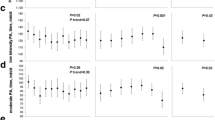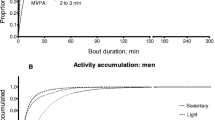Abstract
To examine sources of variance in objectively measured physical activity and to determine the number of monitoring days needed to quantify physical activity patterns reliably, 394 Flemish adults (41.1 ± 9.9 years) were monitored during 7 days, using the SenseWear Armband. Differences between weekdays, Saturday and Sunday were examined with repeated measures ANOVA’s. Variance components were estimated for subject, weekday and residual error using data from Mondays through Fridays and used to calculate the reliability of 1–5 monitoring weekdays. Saturday was more and Sunday less active than an average weekday. Inter-individual variability was the largest source of variance (54.4–67.9%) for physical activity level (PAL), energy expenditure, inactivity, light, moderate and total physical activity. Intra-individual variability accounted for 31.8–44.8% and weekday for 0.1–1.1% of total variance. Intra-individual variability was the largest source of variance for vigorous activity in both sexes and steps in women. At least, 3 monitoring weekdays were required to achieve a reliability of 0.80 for PAL, energy expenditure, inactivity, light, moderate and total physical activity. All 5 weekdays should be monitored to reach acceptable reliability for steps. Five weekdays resulted in a reliability of 0.58–0.60 for vigorous activity. Both Saturday and Sunday and at least 3 weekdays need to be monitored to obtain reliable measures of habitual physical activity.

Similar content being viewed by others
References
Ainsworth BE, Haskell WL, Whitt MC, Irwin ML, Swartz AM, Strath SJ, O’Brien WL, Bassett DR Jr, Schmitz KH, Emplaincourt PO, Jacobs DR Jr, Leon AS (2000) Compendium of physical activities: an update of activity codes and MET intensities. Med Sci Sports Exerc 32:S498–S504
Baranowski T, de Moor C (2000) How many days was that? Intra-individual variability and physical activity assessment. Res Q Exerc Sport 71:S74–S78
Baranowski T, Smith M, Thompson WO, Baranowski J, Hebert D, de Moor C (1999) Intraindividual variability and reliability in a 7-day exercise record. Med Sci Sports Exerc 31:1619–1622
Baranowski T, Masse LC, Ragan B, Welk G (2008) How many days was that? We’re still not sure, but we’re asking the question better!. Med Sci Sports Exerc 40:S544–S549
Bassett DR Jr (2000) Validity and reliability issues in objective monitoring of physical activity. Res Q Exerc Sport 71:S30–S36
Buchowski MS, Acra S, Majchrzak KM, Sun M, Chen KY (2004) Patterns of physical activity in free-living adults in the Southern United States. Eur J Clin Nutr 58:828–837
Catellier DJ, Hannan PJ, Murray DM, Addy CL, Conway TL, Yang S, Rice JC (2005) Imputation of missing data when measuring physical activity by accelerometry. Med Sci Sports Exerc 37:S555–S562
Chen KY, Bassett DR Jr (2005) The technology of accelerometry-based activity monitors: current and future. Med Sci Sports Exerc 37:S490–S500
Coleman KJ, Epstein LH (1998) Application of generalizability theory to measurement of activity in males who are not regularly active: a preliminary report. Res Q Exerc Sport 69:58–63
Corder K, Brage S, Ekelund U (2007) Accelerometers and pedometers: methodology and clinical application. Curr Opin Clin Nutr Metab Care 10:597–603
Donahoo WT, Levine JA, Melanson EL (2004) Variability in energy expenditure and its components. Curr Opin Clin Nutr Metab Care 7:599–605
Dunton GF, Whalen CK, Jamner LD, Henker B, Floro JN (2005) Using ecologic momentary assessment to measure physical activity during adolescence. Am J Prev Med 29:281–287
Gretebeck RJ, Montoye HJ (1992) Variability of some objective measures of physical activity. Med Sci Sports Exerc 24:1167–1172
Hagstromer M, Oja P, Sjostrom M (2007) Physical activity and inactivity in an adult population assessed by accelerometry. Med Sci Sports Exerc 39:1502–1508
Haskell WL, Lee IM, Pate RR, Powell KE, Blair SN, Franklin BA, Macera CA, Heath GW, Thompson PD, Bauman A (2007) Physical activity and public health: updated recommendation for adults from the American College of Sports Medicine and the American Heart Association. Med Sci Sports Exerc 39:1423–1434
Jakicic JM, Marcus M, Gallagher KI, Randall C, Thomas E, Goss FL, Robertson RJ (2004) Evaluation of the SenseWear Pro Armband to assess energy expenditure during exercise. Med Sci Sports Exerc 36:897–904
Johannsen DL, Calabro MA, Stewart J, Franke W, Rood JC, Welk GJ (2010) Accuracy of armband monitors for measuring daily energy expenditure in healthy adults. Med Sci Sports Exerc 42:2134–2140
Johnson M, Baranowski T (1996) Estimating and evaluating correlation structures in repeated measures designs using the GLM and MIXED procedures. In: SAS Users Group International Proceedings (SUGI 21)
Kang M, Bassett DR, Barreira TV, Tudor-Locke C, Ainsworth B, Reis JP, Strath S, Swartz A (2009) How many days are enough? A study of 365 days of pedometer monitoring. Res Q Exerc Sport 80:445–453
Levin S, Jacobs DR Jr, Ainsworth BE, Richardson MT, Leon AS (1999) Intra-individual variation and estimates of usual physical activity. Ann Epidemiol 9:481–488
Levine JA (2007) Nonexercise activity thermogenesis—liberating the life-force. J Intern Med 262:273–287
Masse LC, Fuemmeler BF, Anderson CB, Matthews CE, Trost SG, Catellier DJ, Treuth M (2005) Accelerometer data reduction: a comparison of four reduction algorithms on select outcome variables. Med Sci Sports Exerc 37:S544–S554
Matthews CE (2002) Use of self-reports instruments to assess physical activity. In: Welk GJ (ed) Physical activity assessments for health-related research. Human Kinetics, Champaign, pp 107–123
Matthews CE, Hebert JR, Freedson PS, Stanek EJ III, Merriam PA, Ebbeling CB, Ockene IS (2001) Sources of variance in daily physical activity levels in the seasonal variation of blood cholesterol study. Am J Epidemiol 153:987–995
Matthews CE, Ainsworth BE, Thompson RW, Bassett DR Jr (2002) Sources of variance in daily physical activity levels as measured by an accelerometer. Med Sci Sports Exerc 34:1376–1381
Mattocks C, Leary S, Ness A, Deere K, Saunders J, Kirkby J, Blair SN, Tilling K, Riddoch C (2007) Intraindividual variation of objectively measured physical activity in children. Med Sci Sports Exerc 39:622–629
McGraw KO, Wong SP (1996) Forming inferences about some intraclass correlation coefficients. Psychol Methods 1:30–46
Metzger JS, Catellier DJ, Evenson KR, Treuth MS, Rosamond WD, Siega-Riz AM (2008) Patterns of objectively measured physical activity in the United States. Med Sci Sports Exerc 40:630–638
Miller R, Brown W (2004) Steps and sitting in a working population. Int J Behav Med 11:219–224
Montoye HJ (2000) Introduction: evaluation of some measurements of physical activity and energy expenditure. Med Sci Sports Exerc 32:S439–S441
Paul DR, Kramer M, Stote KS, Spears KE, Moshfegh AJ, Baer DJ, Rumpler WV (2008) Estimates of adherence and error analysis of physical activity data collected via accelerometry in a large study of free-living adults. BMC Med Res Methodol 8:38
Perry MA, Hendrick PA, Hale L, Baxter GD, Milosavljevic S, Dean SG, McDonough SM, Hurley DA (2010) Utility of the RT3 triaxial accelerometer in free living: an investigation of adherence and data loss. Appl Ergon 41:469–476
Ridley K, Olds T, Hands B, Larkin D, Parker H (2009) Intra-individual variation in children’s physical activity patterns: Implications for measurement. J Sci Med Sport 12:568–572
St-Onge M, Mignault D, Allison DB, Rabasa-Lhoret R (2007) Evaluation of a portable device to measure daily energy expenditure in free-living adults. Am J Clin Nutr 85:42–749
Togo F, Watanabe E, Park H, Yasunaga A, Park S, Shephard RJ, Aoyagi Y (2008) How many days of pedometer use predict the annual activity of the elderly reliably? Med Sci Sports Exerc 40:1058–1064
Troiano RP, Berrigan D, Dodd KW, Masse LC, Tilert T, McDowell M (2008) Physical activity in the United States measured by accelerometer. Med Sci Sports Exerc 40:181–188
Trost SG, McIver KL, Pate RR (2005) Conducting accelerometer-based activity assessments in field-based research. Med Sci Sports Exerc 37:S531–S543
Tudor-Locke C, Ham SA, Macera CA, Ainsworth BE, Kirtland KA, Reis JP, Kimsey CD Jr (2004) Descriptive epidemiology of pedometer-determined physical activity. Med Sci Sports Exerc 36:1567–1573
Tudor-Locke C, Burkett L, Reis JP, Ainsworth BE, Macera CA, Wilson DK (2005) How many days of pedometer monitoring predict weekly physical activity in adults? Prev Med 40:293–298
Wareham NJ, Rennie KL (1998) The assessment of physical activity in individuals and populations: why try to be more precise about how physical activity is assessed? Int J Obes Relat Metab Disord 22 Suppl 2:S30-S38
Warren JM, Ekelund U, Besson H, Mezzani A, Geladas N, Vanhees L (2010) Assessment of physical activity—a review of methodologies with reference to epidemiological research: a report of the exercise physiology section of the European Association of Cardiovascular Prevention and Rehabilitation. Eur J Cardiovasc Prev Rehabil 17:127–139
Welk GJ, McClain JJ, Eisenmann JC, Wickel EE (2007) Field validation of the MTI Actigraph and BodyMedia armband monitor using the IDEEA monitor. Obesity (Silver Spring) 15:918–928
Westerterp KR (2009) Assessment of physical activity: a critical appraisal. Eur J Appl Physiol 105:823–828
Wickel EE, Welk GJ (2010) Applying generalizability theory to estimate habitual activity levels. Med Sci Sports Exerc 42:1528–1534
Acknowledgments
T. Scheers was funded by the Research Foundation Flanders.
Conflict of interest
The authors declare that they have no conflict of interest.
Author information
Authors and Affiliations
Corresponding author
Additional information
Communicated by Klaas R Westerterp.
Rights and permissions
About this article
Cite this article
Scheers, T., Philippaerts, R. & Lefevre, J. Variability in physical activity patterns as measured by the SenseWear Armband: how many days are needed?. Eur J Appl Physiol 112, 1653–1662 (2012). https://doi.org/10.1007/s00421-011-2131-9
Received:
Accepted:
Published:
Issue Date:
DOI: https://doi.org/10.1007/s00421-011-2131-9




